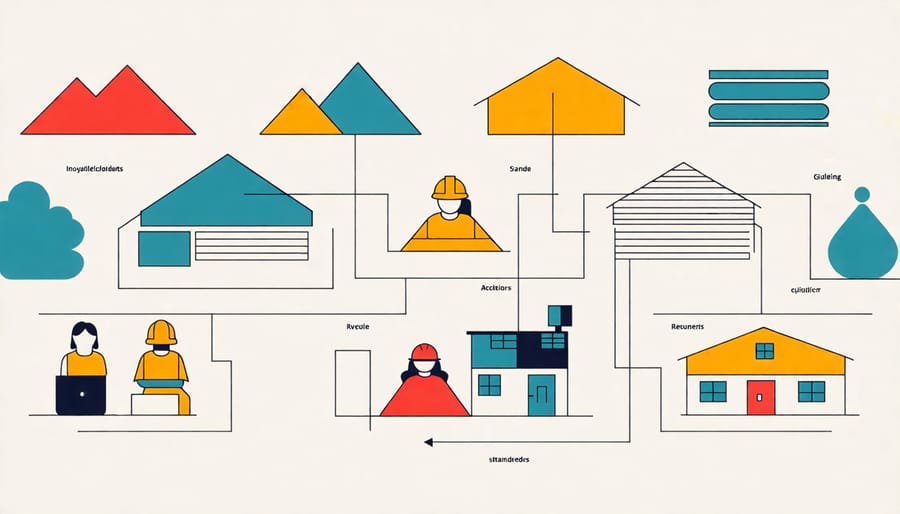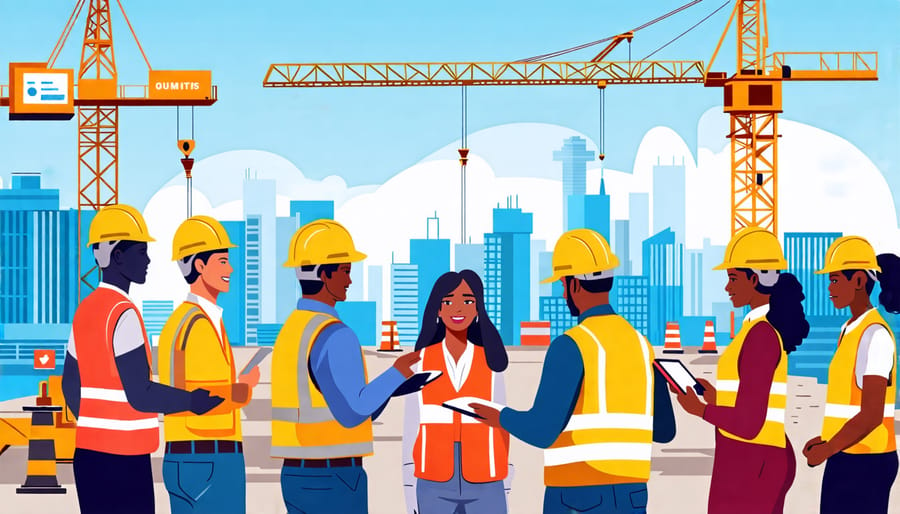Identify stakeholders early by mapping their influence and interest; this ensures proactive engagement tailored to their needs. Foster transparent communication channels, utilizing regular updates and feedback loops through meetings or digital platforms to build trust and avoid misunderstandings. Leverage expert insights and real-world case studies to create stakeholder-specific strategies, enhancing buy-in and minimizing resistance during project phases. Implement continuous assessment and adaptation of engagement strategies to align with evolving project dynamics and stakeholder expectations, ensuring sustained cooperation and successful outcomes.
Understanding Stakeholder Engagement
Key Principles of Stakeholder Engagement
Effective stakeholder engagement is anchored in transparency, trust-building, and proactive communication. These principles are critical in fostering collaborative relationships and preventing project overruns. Transparency ensures stakeholders are informed, reducing ambiguity and aligning expectations. Building trust involves honoring commitments and demonstrating reliability, which enhances mutual respect and facilitates smoother negotiations. Proactive communication entails anticipating stakeholder needs and maintaining open channels for dialogue, which is crucial for adapting to evolving project dynamics. By embedding these principles, industry professionals unlock the benefits of effective stakeholder engagement, thereby improving project outcomes and stakeholder satisfaction.
Types of Stakeholders in Construction
Construction projects involve diverse stakeholders, each with unique roles and interests. Key stakeholders include clients and owners, who initiate projects and have overarching interests in timelines and budgets. Architects and engineers design and ensure structural integrity, balancing creativity with functionality. Contractors and subcontractors execute the construction, focused on efficiency and quality. Regulators and local authorities ensure compliance with safety and zoning laws. Additionally, suppliers provide essential materials, influencing project cost and time. Community members, including residents affected by construction, have stakes in environmental and social impacts. Engaging all stakeholders effectively is crucial for project success and sustainability.

Best Practices for Stakeholder Engagement
Early and Inclusive Engagement
Involving stakeholders from the outset of a construction project is pivotal for securing their input, fostering collaboration, and achieving successful outcomes. Early engagement ensures that diverse perspectives are incorporated into the project’s design and implementation, thereby enhancing decision-making processes and mitigating potential conflicts down the line. By cultivating an inclusive environment that welcomes varied insights, architects, engineers, and project managers can identify and address stakeholder concerns more effectively, leading to heightened support and trust.
Moreover, early and inclusive engagement can significantly enhance project efficiency and innovation. Drawing from expert interviews and in-depth case studies, it is evident that projects benefiting from broad stakeholder participation often see more adaptive and resilient solutions. This practice not only addresses technical challenges but also aligns the project more closely with community needs and environmental goals. By promoting inclusivity from the beginning, construction professionals can leverage the collective expertise of all stakeholders, resulting in projects that are not only technically sound but also socially and environmentally responsible.
Clear Communication Strategies
Effective stakeholder engagement in the construction industry hinges on clear, open, and continuous communication. To achieve this, establish regular communication channels like weekly updates or monthly meetings tailored to the project’s needs and complexity. Employ a mix of digital platforms and face-to-face interactions to suit the preferences of diverse stakeholders, ensuring everyone stays informed in real time. Use concise and technical language when needed, but avoid excessive jargon to maintain clarity and understanding across the board. Foster transparency by swiftly addressing concerns and sharing key developments, creating trust and reducing uncertainty. Acknowledging and incorporating stakeholder feedback can also enhance project outcomes and stakeholder satisfaction. Expert interviews reveal that integrating stakeholder input early in the process significantly reduces project delays and misalignments. Studies highlight the importance of a designated communication lead, responsible for crafting and disseminating crucial information consistently. This proactive approach not only streamlines project delivery but also strengthens long-term professional relationships, paving the way for future collaborations.

Utilizing Technology
In the construction industry, harnessing technology is pivotal for effective stakeholder engagement and enhancing project transparency. Modern digital tools, such as Building Information Modeling (BIM) platforms and cloud-based project management software, allow for real-time data integration and visualization, ensuring all stakeholders are informed and aligned throughout the project lifecycle. Such technologies facilitate seamless communication between architects, engineers, and project managers, reducing misunderstandings and fostering collaboration. For instance, incorporating virtual reality (VR) tools can provide stakeholders with immersive project walkthroughs, enabling better decision-making and consensus-building. Moreover, leveraging data analytics tools helps in tracking project progress, budgeting, and identifying potential risks early, which enhances accountability. Expert interviews reveal that integrating these technologies can lead to a more effective stakeholder engagement strategy, as demonstrated in multiple in-depth case studies. By embracing these innovative solutions, construction professionals can optimize project outcomes and build trust with all involved parties, ensuring projects are delivered on time and within budget.
Conflict Resolution and Negotiation
Resolving stakeholder conflicts and effectively negotiating interests are vital for advancing project goals in the construction sector. To start, establishing clear communication channels is crucial. Regular meetings and updates ensure transparency and help manage expectations. Encourage active listening to understand each stakeholder’s concerns and interests thoroughly. In cases of conflict, employing a collaborative problem-solving approach is beneficial. This involves stakeholders collaboratively identifying issues, generating solutions, and reaching a consensus that aligns with the project’s objectives.
Negotiation skills are equally important, particularly in balancing diverse stakeholder interests. Focus on interests, not positions, to discover mutually beneficial outcomes. It is also useful to develop a set of non-negotiables for each party and explore creative options to satisfy these essentials without compromising the overall project. In complex situations, consider engaging a neutral third-party mediator to facilitate discussion and guide parties toward an agreement. Through these techniques, construction professionals can effectively manage stakeholder engagement, minimize disputes, and keep projects on track.
Case Studies: Success Stories

Case Study 1: Major Infrastructure Project
The Sydney Metro Northwest project remains a pivotal example of stakeholder engagement effectively harnessed in a major infrastructure context. The project involved constructing a high-frequency rail system to improve Sydney’s public transport network, demanding collaboration across various sectors. Core to its success was early and continuous engagement with stakeholders, including local communities, environmental groups, and regulatory bodies, ensuring transparency and trust throughout the project’s lifecycle. By implementing open forums and regular updates, project managers kept stakeholders informed and addressed concerns in real-time, significantly reducing opposition and delays. Collaborative platforms allowed architects and engineers to integrate stakeholder feedback into the design, aligning the infrastructure’s impact with community expectations. Pertinent to this case was the project’s adaptability, ensuring that stakeholders’ input translated into tangible actions, thereby enhancing social license to operate. This project illustrates the necessity of proactive stakeholder management strategies in achieving operational efficiency and fostering positive public perception, underscoring best practices indispensable for construction professionals seeking project success through effective engagement.
Case Study 2: Renewable Energy Initiative
The renewable energy initiative spearheaded by GreenPower Consortium exemplifies the transformative impact of strategic stakeholder engagement. The project aimed to install a wind farm in a historically underserved region, with significant collaboration between developers, local communities, governmental agencies, and environmental groups. By conducting expert interviews with community leaders and hosting transparent forums, GreenPower ensured that stakeholder concerns were addressed and integrated into project planning. This inclusive approach not only streamlined regulatory approvals but also fostered community support, enhancing regional trust and investment.
Importantly, GreenPower partnered with local construction companies and employed local workers, directly linking stakeholder engagement with economic benefits for the community. Engineers and project managers worked closely with local architects to design structures that harmonized with the landscape, minimizing visual and environmental impact. Through these efforts, the initiative not only achieved its sustainability goals but also set a new benchmark for engagement practices in the renewable energy sector, providing a replicable model for future projects.
Challenges and Solutions in Stakeholder Engagement
Addressing Diverse Interests
To effectively manage and align diverse stakeholder interests, construction professionals should employ strategic engagement techniques that emphasize communication, collaboration, and flexibility. Start by clearly identifying all stakeholder interests through comprehensive assessments, including expert interviews and in-depth case studies, to understand each party’s expectations and concerns. By establishing open communication channels early, project managers can facilitate ongoing dialogue and transparency, allowing stakeholders to voice their needs and adjustments as projects evolve. Engaging stakeholders in collaborative workshops fosters a sense of joint ownership, while conflict resolution strategies ensure balanced outcomes. Adapting project goals to accommodate these diverse interests ultimately leads to more successful and inclusive project execution.
Overcoming Resistance to Change
To effectively manage stakeholder resistance to change in the construction industry, it’s vital to deploy a strategy rooted in communication and inclusivity. Start by identifying potential resistors early through stakeholder mapping, ensuring they are engaged from the outset. Incorporating expert interviews and in-depth case studies can provide compelling evidence of the benefits of new processes or technologies, bolstering stakeholder confidence. Tailored training sessions help alleviate concerns by equipping stakeholders with the knowledge to adapt. Additionally, regular feedback loops create an environment where concerns are openly addressed, facilitating a smoother transition and fostering a culture of continuous improvement.
Conclusion
In conclusion, successful stakeholder engagement is paramount for the advancement of the construction and energy sectors. As explored throughout this article, implementing well-defined strategies can significantly enhance collaboration and project outcomes. Key practices such as early involvement of stakeholders, transparent communication, and leveraging technology such as BIM Modeling in Construction are essential to achieving these goals. These techniques not only facilitate clearer understanding and alignment among all parties but also mitigate risks and foster a culture of trust. Insights from expert interviews and in-depth case studies underline the effectiveness of these methods, highlighting real-world successes. As industry decision-makers and professionals, incorporating these best practices into your projects can lead to improved efficiencies and stakeholder satisfaction, ultimately driving the sector towards more sustainable and innovative futures. Embracing these strategies is a decisive step towards building enduring partnerships and resilient infrastructures.

